Continuing this story… The innards of the Ruger 22/45 are not the only pieces of metal in need of 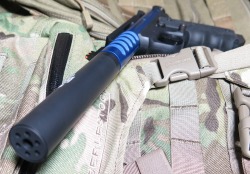 modernization. There are plenty of upgrades necessary on the outside of the pistol to make this a B.O.L.T.-worthy tool. For instance, the magazine baseplates, the grip, the threaded barrel protector, carry options, and of course the sights. And speaking of sights, the stock Ruger 22/45 iron sights are near impossible to see.
modernization. There are plenty of upgrades necessary on the outside of the pistol to make this a B.O.L.T.-worthy tool. For instance, the magazine baseplates, the grip, the threaded barrel protector, carry options, and of course the sights. And speaking of sights, the stock Ruger 22/45 iron sights are near impossible to see.
By Doc Montana, a contributing author
This is the second article in a 2 part series (Read Part 1)
Night Blindness
The rear sight is little more than a flat black square notch that centers a thick flat black front sight blade 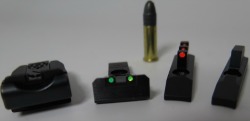 ensuring the stock sights are nearly useless. Low light situations are out of the question, and anything with a dark or variable colored background makes sight alignment nearly impossible. Since sights are imperative to accuracy, quality aftermarket sights are a must. In this case, Williams FireSights were the obvious choice. No, I’m going to take this further. If you don’t update the sights, in specific to FireSights, then it would seem that you are not taking this situation seriously. The fiber optic light gathering and contrasting colors make the Fire Sights embarrassingly better than the stock irons. The brilliant glowing green and orange dots are nothing short of magic. For less than fifty bucks, you can put your 22/45 on target every time, not just when conditions afford visibility of flat black on flat black.
ensuring the stock sights are nearly useless. Low light situations are out of the question, and anything with a dark or variable colored background makes sight alignment nearly impossible. Since sights are imperative to accuracy, quality aftermarket sights are a must. In this case, Williams FireSights were the obvious choice. No, I’m going to take this further. If you don’t update the sights, in specific to FireSights, then it would seem that you are not taking this situation seriously. The fiber optic light gathering and contrasting colors make the Fire Sights embarrassingly better than the stock irons. The brilliant glowing green and orange dots are nothing short of magic. For less than fifty bucks, you can put your 22/45 on target every time, not just when conditions afford visibility of flat black on flat black.
Grip Matters
The grips on the 22/45 are, well, like a government issue .45 auto which is exactly where the 22/45 gets its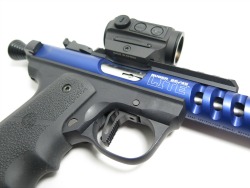 name. As a diehard Glock fanboy who was born with a Glock grip angle on my first toy rattle. But the semi-slippery scales that screw onto to the handle of the 22/45 can benefit from a rubberized upgrade. And it’s Hogue to the rescue. By providing a grippier circumference to snuggle up with, the Houge’s offer a positive interaction between shooter and machine. But as a Glockster, the finger indexing on the Hogue lock in a positive interface making aiming the Lite intuitive and rock solid.
name. As a diehard Glock fanboy who was born with a Glock grip angle on my first toy rattle. But the semi-slippery scales that screw onto to the handle of the 22/45 can benefit from a rubberized upgrade. And it’s Hogue to the rescue. By providing a grippier circumference to snuggle up with, the Houge’s offer a positive interaction between shooter and machine. But as a Glockster, the finger indexing on the Hogue lock in a positive interface making aiming the Lite intuitive and rock solid.
One In The Holster
Carrying all this .22LR firepower all day every day requires a suitable holster. And none serves this duty 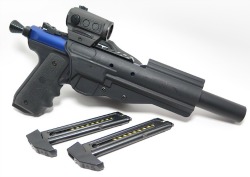 better than the Blackdog. As a adjustable friction fit Kydex containment system for all things Ruger (and a Benchmark), the Blackdog could care less about barrel length, and to a certain extent suppressor length. Hint, hint. But back on topic, for this exercise I chose the Low Ride Blackdog. I like high ride holsters for aggressive carry, and low ride for day to day open carry.
better than the Blackdog. As a adjustable friction fit Kydex containment system for all things Ruger (and a Benchmark), the Blackdog could care less about barrel length, and to a certain extent suppressor length. Hint, hint. But back on topic, for this exercise I chose the Low Ride Blackdog. I like high ride holsters for aggressive carry, and low ride for day to day open carry.
Holosun? Yea, I Heard Of Them
Finally the optic. I was all ready to snap on an Aimpoint Micro onto the OEM rail. But then Holosun 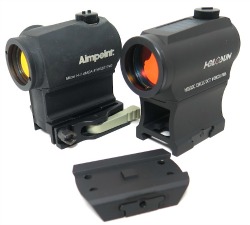 HS503C caught my eye. In roughly the same form factor as the Aimpoint, the Holosun HS503C incorporates two reticle options as well as running on both solar and battery power. One thing I really liked about EOTech sights (about the only thing) is the large sighting ring, something around 65 MOA. A single small red dot is great when you can see clearly and have a good cheek weld, but waving a pistol around trying to find the dot can be a challenge especially if the shooter is in motion. There are just a few degrees of movement where the dot appears in a micro-sized tube at arm’s length. Having the choice of large ring or small dot gives the shooter the best of both worlds.
HS503C caught my eye. In roughly the same form factor as the Aimpoint, the Holosun HS503C incorporates two reticle options as well as running on both solar and battery power. One thing I really liked about EOTech sights (about the only thing) is the large sighting ring, something around 65 MOA. A single small red dot is great when you can see clearly and have a good cheek weld, but waving a pistol around trying to find the dot can be a challenge especially if the shooter is in motion. There are just a few degrees of movement where the dot appears in a micro-sized tube at arm’s length. Having the choice of large ring or small dot gives the shooter the best of both worlds.
Also Read: The Hurricane Katrina Rifle
And while the Holosun has a battery life in the ballpark of Aimpoint’s three million minutes (50,000 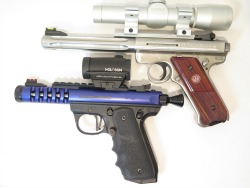 hours=2083 days=five years eight-and-a-half months). Although the solar does not charge the battery and needs the sun, low light shooting with a dead battery will require iron sights. But enough dust should have settled in five years to not need to sneak around in the dark.
hours=2083 days=five years eight-and-a-half months). Although the solar does not charge the battery and needs the sun, low light shooting with a dead battery will require iron sights. But enough dust should have settled in five years to not need to sneak around in the dark.
My main comparable in optics on a .22 pistol is my Ruger Mark III Target pistol with fluted bull barrel and Leupold 2X pistol scope. While the Mark III is better at long range and more accurate with the crosshairs, the Holosun topped 22/45 was much faster on target massively lighter.
Shhhhhh…
Sound is a dead giveaway. Even the pop of a .22 will attract attention and scare game. So a true Bug 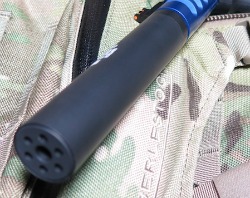 Out pistol would not be complete without a suppressor. Unscrewing the Game Changer Compensator and threading on the Gemtech Outback II drops the decibels to the “what was that?” level. If that.
Out pistol would not be complete without a suppressor. Unscrewing the Game Changer Compensator and threading on the Gemtech Outback II drops the decibels to the “what was that?” level. If that.
Gemtech is a leader in suppressor (or silencer to the Hollywood crowd). Based in Boise, Idaho, Gemtech produces some of the finest and lightest suppressors on the planet. The Outback II is a high-end ultra lite .22LR only suppressor. It’s certainly not the least expensive, but certainly one of the higher performing and higher options available from your Class-3 dealer. And if you want to upgrade your Outback II, you can opt for the G-Core upgrade for another pair of Benjis.
Sound suppression should be a fact of life, but instead the NFA makes it a $200 tax plus paperwork, fingerprints, signatures, and a few months of waiting. But that should not be too much to swallow when it comes to an optimal bug out gun. Spinning on a suppressor opens some doors otherwise closed to ear-ringing decibel damage. For the cost of just five more barrel inches and 2.7 ounces, the silence is defining.
When subsonic ammo pops out the far end of the suppressor at less than 1100 feet per second the B.O.L.T. Pistol spatters lead down range both accurately and with no more sound than the bolt cycling, usually by hand.
Compensating For Something?
A stock 22/45 with a threaded barrel comes with a small protector. Tandemkross makes a Compensator 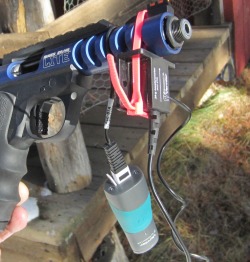 that works wonders whether on pistol or rifle. The muzzle jump on a .22 is near-zero, but the compensator does reduce it. I measured the upward acceleration of the muzzle using a Vernier accelerometer comparing the compensator to a bare muzzle and with a supressor. The Tandemkross Game Changer compensator noticeably reduced the muzzle flip, and redirected the muzzle blast away from down. Normally not a problem with a pistol since you are not shooting with the barrel just inches above dirt, but I did notice it when shooting off a snow-covered rest.
that works wonders whether on pistol or rifle. The muzzle jump on a .22 is near-zero, but the compensator does reduce it. I measured the upward acceleration of the muzzle using a Vernier accelerometer comparing the compensator to a bare muzzle and with a supressor. The Tandemkross Game Changer compensator noticeably reduced the muzzle flip, and redirected the muzzle blast away from down. Normally not a problem with a pistol since you are not shooting with the barrel just inches above dirt, but I did notice it when shooting off a snow-covered rest.
Rubber On Road?
So how does all this B.O.L.T. kit shoot? Like a dream! The flow from presentation to trigger pull to bang (or muted pihfft) is a scary reminder how little weight and effort can change the game. Ted Kaczynski (the Unabomber) lived in a cabin just a few miles upstream from my favorite fishing hole. He was known for quietly poaching deer by shooting them in the eyeball with a .22 rifle. Where long guns differ from handguns is mostly in sight radius. The reason a pistol would ever need a long barrel is not necessarily to give the powder more burn time, or more spins on the bullet as it zings down the pipe, but in fact to hold the front sight further away from the rear peep. But a red dot sight negates all that sight radius stuff since it makes no difference anymore. So a four inch barrel is as useful as an eight inch one. The red dot sight used here makes accuracy not an issue of front post on target, but red speck on topic.
Holding the gun steady is the issue, not keeping the dot on prey. Painting the target is easy. Pulling the trigger while the dot is where it needs to be becomes the challenge. But that is a good problem. Plus, you can hand the gun to anyone and it will be obvious that the red dot means kill. Nobody would second-guess the operation of a red dot sight where irons take understanding.
Downrange
At 15 yards off a rest this B.O.L.T. gun easily makes one ragged hole in paper with CCI ammo. Well, most 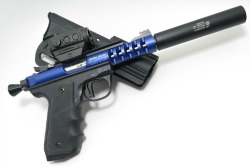 of the time. Enough of the time. Out to 50 yards, it’s possible to keep the pistol on a dinner plate since the Holosun red dot sight couldn’t care less if it was on a handgun, rifle, or Sherman tank. A single point of red light has no sight radius. But if one restricted the target size to the orbital cavity in a deer skull, anything under 25 yards could be considered ethical…in a SHTF sort of way.
of the time. Enough of the time. Out to 50 yards, it’s possible to keep the pistol on a dinner plate since the Holosun red dot sight couldn’t care less if it was on a handgun, rifle, or Sherman tank. A single point of red light has no sight radius. But if one restricted the target size to the orbital cavity in a deer skull, anything under 25 yards could be considered ethical…in a SHTF sort of way.
In the end what one needs in a bug out tool gun is a reliable machine that can deal with day-to-day chores as society rebuild itself for too long we’ve tried to find the perfect gun for all situations but in the end what you really need something that can live a few grains of lead downrange and dispatch the furry or feathered food with precision simplicity and elegance. Although the B.O.L.T. gun is not THE perfect solution, it is A perfect solution for an imperfect world.
All Photos By Doc Montana.

12 comments
” A four inch barrel is as useful as a eight inch one”, really! Doesn’t the increased speed and spin-induced accuracy make the chance of hitting a small target more likely? If it doesn’t, then just throw a rock and don’t bother to carry a gun at all! There are far fewer rules and regs on rocks than guns. Suppressed or not, IMHO, you rarely get a second shot; at 25 yards, most animals are going to react to the sound your shot makes and a moving target is much harder to hit. Question: Does five inches of suppressor increase the speed of the projectile or does the bleed-off negate the extra ‘barrel’ length? I think I’ll stay with my Ruger Mark 1 six inch target-barrel and SSS subsonic ammo for quiet and stinger ammo for rowdier critters! It’s worked well so far and $200 buys a lot of ammo, when you can find it! Ya, I’m a party pooper! GLAHP!
I have used Williams Firesights in the past personally, and installed them on MANY firearms for customers. They work great, but I have had more than one instance where the very thin metal band holding in the fiber optic tube on the front sight breaks, leaving the cube floating back and forth and necessitating some a touch of epoxy to secure. In one situation, a customer had set his Firesight-equipped Winchester 94 in a corner a tough too roughly, and the bands snapped. If I’m going fiber optic, I prefer something a touch sturdier like the Ameriglo options. I prefer encased tritium lamp sights even better – case in point Trijicon HD. Just my $0.02. A supressed .22 semi-auto is definitely on the short list. Great build!
Thanks for the read Roger.
Ballistically, the difference between 4″ and 8″ barrels is quite minimal, and far down on the list of accuracy issues. Yes, it makes a difference. But no, that difference is near-impreceptable in real-world shooting.
If the doubling were say a 8″ barrel to a 16″ one, or a 10″ to a 20″, the there are major changes. But 4″ to 8″ is not enough on the surface unless one was so incline to match rounds i.e. bullet design, weight and power charge with a particular barrel and twist. At that point some measurable accuracy could come of it. But with a .22 being limited in bullet choice and essentially unreloadable, pushing the argument further is strictly academic. Even worse, the thin-walled “lite” barrel of the gun in question has inherent accuracy issues compared to the heavy barreled target model I compared it to.
One more thing. When shooting the larger, heavier bullets to remain subsonic, the deliberate slowness of the round brings additional accuracy challenges to the table. So while discussions like this are fruitful and even fun, running around the bug out with the B.O.L.T. Pistol provides more than enough accurate firepower to put dinner on the campfire and keep the curious at bay.
Regarding the suppressor, I have not chronographed the bullet speed, but other sources who have tested such things concluded that modern suppressors don’t do much to bullet speed in either direction.
Frankly Roger, I think 99% of the solution to the equation we are trying to solve is found in the skills of the one holding the gun.
All in, what do you have in that gun?
Here’s what I wrote in part 1:
From memory, street price the gun is about $400. The Tandemkross internals are about $110, a few external enhancements including the charging cone, compensator, mag bumpers and grips is another $130. Trigger is $35. Fire Sights are $50. Holster is $35. Holosun is $240. Suppressor is $325 plus a $200 tax stamp and $20 fingerprinting charge.
All those numbers are rough and I might have forgotten something, but ballpark for this particular B.O.L.T. gun just under $1000 with all the goodies but the suppressor. Add another five and a half for that. My initial plan was to use an Aimpoint Micro which would have added another $500 above the Holosun.
That’s about the same price as good fly rod and reel, a used good mountain bike, a performance paddle board, a purebred dog, an engagement ring, a Macbook Pro, some off-road tires, a digital camera,. Heck, I even know some folks who paid that much for their cars. Crazy huh?
one hell of fly rod……the rest is worth the cost.
Your budget for a .22LR pistol is MUCH higher than mine, yes, my envy is showing! Thank you for answering my question about the speed difference a suppressor makes! I learned much about accuracy from shooting .22LR target rifles in a JROTC class, back when that was allowed. Maybe because of that, I still prefer double peep sights over most optics, of course, long range requires a high-powered scope (at least for me, getting old). Does anyone produce double-peep sights for the Ruger Mk1, please tell! Since .22 rimfire is only (as far as I know) only mass produced, accuracy is going to suffer but that also keeps the price down. Do you think that the .22 LR being sold as precision target ammo is worth the higher cost? Except for people that are bench shooters, does that 1/4 inch (?) or so at 25 yards make any tangible difference? May I suggest that an article on the eight steady hold factors would be quite welcome, hint, hint! One of the reasons I don’t buy a suppressor is the perception that LEOs have of it, Hollyweird portrays them as the tool of assassins! If I were a LEO I would probably have the same bias, better safe than sorry! Thank you again.
Hi Roger,
Great questions. First regarding the peep sights, I don’t know of one for the Mark 1 offhand, but there is a big peep sight community within the biathlon (ski/shoot) folks. I race biathlon occasionally and the only legal sights are irons with the predominance being peeps. But hold on to you hat when it comes to price. And hey, I never said my eyes were young. I’m a fan red dots, and eyesight is one of the reasons.
Funny you should mention match .22 ammo. I bought a bunch of it when that was all there was available. The stuff is premium, but I only noticed the difference when off the bench using my Ruger 77/22 stainless all-weather bolt action rifle with 3×9 scope and shooting paper at 25-50 yards (I rarely spend much time shooting paper with a .22 farther than than because I have to walk out to the target to see the hole (I’m too cheap to buy color-changing target, but probably should).
The difference I noticed with match ammo was not so much in better accuracy but in tighter groups.
Suppressors are legal around here for hunting so running around the woods with one should not raise many eyebrows. But walking through a dark alley at night with one would certainly conjure up visions of Hollywood.
The .22 hand gun is on my list and i like your set up. If you ever needed a BOLT gun then your options on food would be small game and this is ideal. No one is shooting an elk with 333 Lupa and preserving the meat. Plus big game will be long gone.
Exactly BamaMan. Your point is my point.
What I find so innrteseitg is you could never find this anywhere else.
prblkwp